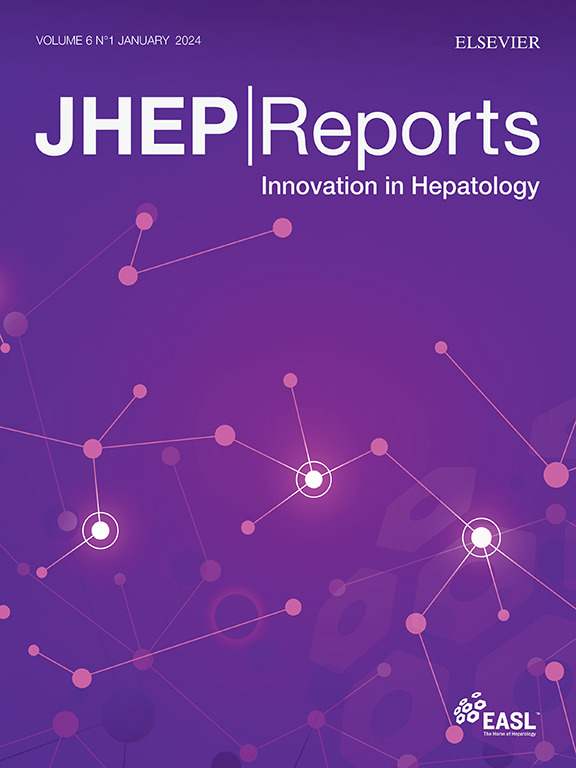心脏代谢危险因素对MASLD肝纤维化和临床结局的影响:一项基于人群的多队列研究
IF 9.5
1区 医学
Q1 GASTROENTEROLOGY & HEPATOLOGY
引用次数: 0
摘要
背景,目的评估5种心脏代谢危险因素(CMRFs)对诊断代谢功能障碍相关脂肪变性肝病(MASLD)至关重要。本研究探讨了CMRFs对MASLD患者肝纤维化和长期临床结局的影响。方法纳入两个横断面队列(韩国磁共振弹性成像[n = 6,684]和美国振动控制瞬态弹性成像[n = 6,230]),评估五种CMRFs及其组合对肝纤维化的影响。两个纵向队列(UK Biobank [n = 408,544;平均随访14.3年]和韩国国民健康保险数据[n = 355,640;平均随访时间为11.7年]),以评估长期预后,包括肝脏相关事件、肝细胞癌事件以及总体、心血管和肝脏相关死亡。使用logistic或Cox回归分析评估与CMRFs相关的MASLD风险,参考无脂肪变性肝病的参与者。结果在所有四个队列中,2型糖尿病患者发生肝纤维化和长期临床结果的风险最高。在5种CMRFs中,空腹血糖受损(CMRF2)是肝纤维化和长期临床结果的最重要危险因素。高血压(CMRF3)是肝纤维化的第二大危险因素,仅次于CMRF2。低高密度脂蛋白胆固醇水平(CMRF5)对长期临床结果具有相当的意义。这些临床结果随着血糖异常(正常和受损的空腹血糖水平和2型糖尿病)严重程度的增加而恶化。与没有空腹血糖水平受损的患者相比,MASLD和CMRF2患者出现肝纤维化和肝脏相关事件的风险高出2 - 4倍,类似于MASLD伴有任何4种CMRFs。结论5种CMRFs对肝纤维化和长期临床结局的影响因临床结局和人群特征而异。然而,空腹血糖受损(CMRF2)始终显示出最高的风险。影响和意义了解用于代谢功能障碍相关脂肪变性肝病(MASLD)诊断的五种心脏代谢危险因素(CMRFs)对肝纤维化和长期临床结果的影响,可以通过促进MASLD高危个体的识别,提高普通人群的护理质量。在我们的研究结果中,尽管五种CMRFs对肝纤维化和长期临床结果的影响取决于临床结果的类型和人群的特征,但空腹血糖受损(CMRF2)始终显示出最高的风险。与没有空腹血糖水平受损的患者相比,MASLD和CMRF2患者出现肝纤维化和肝脏相关事件的风险高出2 - 4倍,类似于MASLD伴有任何4种CMRFs。利用空腹血糖受损(CMRF2)可以提高初级保健提供者在诊断MASLD时对高危人群的认识。本文章由计算机程序翻译,如有差异,请以英文原文为准。
Impact of cardiometabolic risk factors on hepatic fibrosis and clinical outcomes in MASLD: A population-based multi-cohort study
Background & Aims
Evaluating five cardiometabolic risk factors (CMRFs) is crucial for diagnosing metabolic dysfunction-associated steatotic liver disease (MASLD). This study investigated the impact of CMRFs on hepatic fibrosis and long-term clinical outcomes in patients with MASLD.
Methods
Two cross-sectional cohorts (Korean magnetic resonance elastography [n = 6,684] and US vibration-controlled transient elastography [n = 6,230]) were included to assess the impact of five CMRFs and their combinations on hepatic fibrosis. Two longitudinal cohorts (UK Biobank [n = 408,544; mean follow-up, 14.3 years] and Korea National Health Insurance data [n = 355,640; mean follow-up, 11.7 years]) were included to evaluate long-term outcomes, including liver-related events, hepatocellular carcinoma events, and overall, cardiovascular, and liver-related death. The risk of MASLD associated with CMRFs was assessed using logistic or Cox regression analysis, referencing participants without steatotic liver disease.
Results
Across all four cohorts, patients with type 2 diabetes mellitus had the highest risk of hepatic fibrosis and long-term clinical outcomes. Among the five CMRFs, impaired fasting glucose (CMRF2) was the most significant risk factor for both hepatic fibrosis and long-term clinical outcomes. High blood pressure (CMRF3) was the second most significant risk factor for hepatic fibrosis, following CMRF2. Low high-density lipoprotein cholesterol level (CMRF5) exhibited comparable significance for long-term clinical outcomes. These clinical outcomes worsened with increasing severity of glucose abnormalities (normal and impaired fasting glucose levels and type 2 diabetes mellitus). Patients with MASLD and CMRF2 exhibited a two-to-four times higher risk of hepatic fibrosis and liver-related events compared with those without impaired fasting glucose levels, similar to MASLD accompanied by any four CMRFs.
Conclusions
The impact of the five CMRFs on hepatic fibrosis and long-term clinical outcomes varied across different clinical outcomes and population characteristics. However, impaired fasting glucose (CMRF2) consistently demonstrated the highest risk.
Impact and implications
Understanding the impact of the five cardiometabolic risk factors (CMRFs) used in the diagnosis of metabolic dysfunction-associated steatotic liver disease (MASLD) on hepatic fibrosis and long-term clinical outcomes can improve the quality of care in the general population by facilitating the identification of at-risk individuals with MASLD. In our results, although the impact of each of the five CMRFs on hepatic fibrosis and long-term clinical outcomes varied depending on the type of clinical outcomes and the characteristics of the population, impaired fasting glucose (CMRF2) consistently showed the highest risk. Patients with MASLD and CMRF2 exhibited a two-to-four times higher risk of hepatic fibrosis and liver-related events compared with those without impaired fasting glucose levels, similar to MASLD accompanied by any four CMRFs. The utilization of impaired fasting glucose (CMRF2) can raise awareness among primary care providers regarding high-risk groups at the time of MASLD diagnosis.
求助全文
通过发布文献求助,成功后即可免费获取论文全文。
去求助
来源期刊

JHEP Reports
GASTROENTEROLOGY & HEPATOLOGY-
CiteScore
12.40
自引率
2.40%
发文量
161
审稿时长
36 days
期刊介绍:
JHEP Reports is an open access journal that is affiliated with the European Association for the Study of the Liver (EASL). It serves as a companion journal to the highly respected Journal of Hepatology.
The primary objective of JHEP Reports is to publish original papers and reviews that contribute to the advancement of knowledge in the field of liver diseases. The journal covers a wide range of topics, including basic, translational, and clinical research. It also focuses on global issues in hepatology, with particular emphasis on areas such as clinical trials, novel diagnostics, precision medicine and therapeutics, cancer research, cellular and molecular studies, artificial intelligence, microbiome research, epidemiology, and cutting-edge technologies.
In summary, JHEP Reports is dedicated to promoting scientific discoveries and innovations in liver diseases through the publication of high-quality research papers and reviews covering various aspects of hepatology.
 求助内容:
求助内容: 应助结果提醒方式:
应助结果提醒方式:


